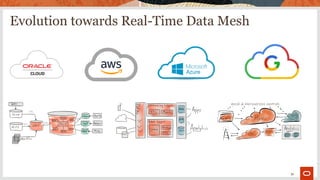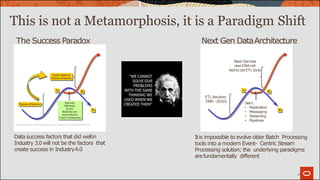Data Engineer, Patterns & Architecture The future: Deep-dive into Microservices Patterns with Stream Process
- 1. Data Engineer, Patterns & Architecture The future: Deep-dive into Microservices Patterns with Stream Process Igor De Souza June - 2 0 2 0
- 2. Copyright © 2020, Oracle and/or its affiliates. All rights reserved. | Safe Harbor Statement The following is intended to outline our general product direction. It is intended for information purposes only, and may not be incorporated into any contract. It is not a commitment to deliver any material, code, or functionality, and should not be relied upon in making purchasing decisions. The development, release, and timing of any features or functionality described for Oracle’s products remains at the sole discretion of Oracle.
- 3. Copyright © 2020, Oracle and/or its affiliates. All rights reserved. | Today’sAgenda • Industry 4.0 • Data Fabric & Data Mesh • Microservices Design Patterns • Is Streaming a Database ? • Streaming Everywhere
- 4. During2020/ 2021the world continuesto go throughaParadigmShift into afuture where“Cyber- PhysicalSystems”arethe newnormal. “Digital Transformation” requires mindset shift: 1.Sharingdatais more effective thanaccumulating 2.Decentralizing,distributing, andcopyingis more powerful than stockpiling 3.Connectivityandflow of datais the starting point for innovation andsocializing.
- 5. 5
- 6. Real-TimeIndustry4.0 …from Industry 3.0 BatchCentric, Schedulers Hubs(EDW,Hadoop,DataLake) Mostly Relational Data(aka Views) SimplexProcessingis Standard Sizefor PeakWorkloads Kimball / Inmon Architecture Governanceis “Bolt On” VendorSpecific …to Industry 4.0 EventCentric,Streams (Edge,Hybrid,Multi-Cloud) PolyglotData(viaLogs) MassivelyParallelisStandard Elastic,ScaleonDemand DistributedKappa GovernanceisEmbedded OpenSourceEnabled 6
- 7. Copyright © 2020, Oracle and/or its affiliates. All rights reserved. | Evolution This data pattern, popularized by Ralph Kimball and Bill Inmon, has been the foundation for enterprise data management since 1993. It is transaction consistent, can scale up nicely for most use cases, and is based on SQL, lingua-franca for most tools. By 2010, the Lambda (big data) pattern was common. In 2014, Jay Kreps (of LinkedIn) questioned the Lambda Architecture and spawned Kappa. The Kappa principles consider batch processing as a special case of stream processing. Use a historized event log to process both real-time as well as batch processing. 7 ETL ETL ETL ETL Monoliths
- 8. 8
- 10. Copyright © 2020, Oracle and/or its affiliates. All rights reserved. | Microservices are Good! Service Mesh Revolution Emergence and widespread use of microservices have directly led to revolution in DevOps, massive uptake in Kubernetes and by 2020 the Service Mesh revolution • Key Benefits: • Decomposition, of monolithic architecture • Modularity, smaller services and improved • speed of initial development • Independence, loosely-coupled systems that can • be created using different languages or data • With the loose coupling also comes much greater flexibility around deployment and upgrades, eliminating complex dependencies • Flexibility at Scale, deployments may start small, run locally and later scale very wide, running across multi-cloud environments and containers • Sidecar pattern for “Mesh” frameworks are 10
- 11. Copyright © 2020, Oracle and/or its affiliates. All rights reserved. | Domain Driven Design (DDD) principles guide developers to create microservices that align to Bounded Contexts, which “defines tangible boundaries of applicability of some sub-domain” Challenges with Bounded Context & DDD Sounds hard! 11
- 12. 12 Service Mesh
- 13. 13 Do not burden my code with all these infrastructure related decisions
- 14. Copyright © 2020, Oracle and/or its affiliates. All rights reserved. | Data and Events are First-Class Citizens Service Service Service Analytics, Data Science and Data Lakes are too important to my business’ Digital Transformation and Data-Driven initiatives… we need architecture focus on Data and Events too Application Microservices Data Stores Event Logs produce events consume events produce events consume events read write App Events Data Events DBLog Events Control Plane • “State of the Truth” at a point in time (current or historic) • Durable storage used for Data Recovery / Archives/years of data • Polyglot, each service may determine its own data structures • “Narrative of the Truth” sequence of events (between data snapshots) • Days/months of event data available as Time Series or Messaging • Strict ordering of events & Idempotency • Strong Consistency of DB logs (eg; whenusing GoldenGate) • “Systems ofRecord” at application tier • APIs, business rules and business object semantics • Not durable storage The microservice API is king! 14
- 15. Copyright © 2020, Oracle and/or its affiliates. All rights reserved. | Can we take some of the best ideas of a Service Mesh and apply them to Data and Events, to create a kind of Data Mesh? Microservice Mesh and Data Mesh Immutable Raw Data Events Prepared Data Canonical Data App Events Data Events DBLog Events Data Domain Projection…n Data Domain Projection 1 Application Microservices Control Plane 15
- 16. What is a Data Mesh? 16 Microservice Patterns Log-based Integrations Polyglot Data Movement Data Mesh is a data-tier architecture to integrate and govern enterprise data assets across distributed multi-cloud environments – two defining characteristics are: (1) De-centralized data processing; no ETL/Hubs/Lake monoliths (2) Event-driven; real-time where possible, batch only when necessary Microservices-centric: • For the administration, deployment and monitoring of the core frameworks of data movement and governance • “Sidecar Proxy” style pattern for Events and Data; Aligns with Service Mesh frameworks (Kubernetes, Istio, etc) Immutable event-logs for data integrations: • Messaging and data store events are globally accessible via immutable event logs • Logs may be used to drive Streaming or Batch integrations Distributed data movement of all types of data • A data mesh moves data: Relational, NoSQL, JSON, Graph… • Relational data consistency (ACID) during data movement • Must work reliably with enterprise OLTP data sets Data Mesh Event Streaming Immutable Logs Data Replication Polyglot Persistence Edge / 5G Frameworks Domain Driven Design Service Mesh “Sidecars” Data Mesh
- 17. 17
- 18. 18
- 19. Data Fabric or Data Mesh? 19
- 21. Microservice Design Patterns for Data Patterns for MicroservicesInherent to the Microservice Architecture is the developer using specific patterns, sometimes the patterns are partially embodied in a Programming Framework, but typically the developers must choose to follow certain heuristics while programming. This presentation’s focus: • “Database Patterns” & “Integration Patterns” …using DBEvent Replication (AKA: Change Data Capture) to improvethem • Simplify the pattern, make the microservice application more resilient and provide better data consistency guarantees DB Patterns for Discussion: • Database per Service (coveredearlier) • CQRS – Command Query Responsibility Segregation • Event Sourcing • Saga Pattern • Transactional Outbox • Aggregates (AKA: Domain Events) Transaction Outbox 21
- 22. Hype Cycle 2009 Complex Event Processing: • CEP is a kind of computing in which incoming data about events is distilled into more useful, higher level event data that provides insight into what is happening. […] CEP is used for highly demanding, continuous-intelligence applications that enhance situation awareness and support real-time decisions. Gartner 20 Years Too Early? • CEP dates back to the 1990’s (history of CEP engines) • CEP came before “Event Stream Processing” andgenerally has covered more complex use cases (eg; handling of out- of-order events and more complicated correlation semantics) ( what’s the difference, 2019 and mythbuster CEP vs ESP, 2008) • Largely overtaken by Big Data stream processing technologies that are open-source, massively-parallel,and widely available as cloud-native 2009! Copyright © 2020 Oracle and/or its affiliates.
- 23. Stream Processing 2020 Time Series DB/OLAP Big Data Event Stream Processing Complex Event Processing Becoming more aligned to open source / apache frameworks Becoming more capable of rich windowing functions and time-clock correlation semantics Complex Event Processing: • Traditionally running in “scale-up” SMP in-memory framework • Many CEP engines aremoving toward MPP “scale-out” architectures • Programming-centric historically, some CEP engines were also query- centric asfar back as 2009 • Time-clock semantics and advanced cache may be used for “state machine” type usecases Stream Processing: • Built around MPP frameworksand typically Apache open-sourced • Genesis was around simplistic use cases on high volumes of events • All SP engines began with rudimentary windowing and correlation semantics, but most frameworks are gradually becoming more functionally comparable to classic CEP • Simplistic windowing and caching for basic stream-clock events Time Series Databases: • Optimized for persistence and historic analytics on time-ordered events…data is often sourced from CEP or SP engines Technical and Functional Differences between CEP and SP:https://complexevents.com/2019/07/15/whats-the-difference-between-esp-and-cep-2/ Copyright © 2020 Oracle and/or its affiliates.
- 24. Stream Processing/CEP for Event Driven Architectures There has been a widespread awakening to the benefits of Event Drive Architecture (EDA) for increasing the scalability and agility of business systems. […] Stream analytics is based on the mathematics of complex-event processing (CEP). CEP is a computing technique in which incoming data about what is happening (event data) is processed as it arrives (data in motion or recently in motion) to generate higher level, more useful, summary information (complex events). W. Roy Schulte (of Gartner), March 2020: EDA is Suddenly Popular Will Stream Analytics be Next? Event Stream Analytics (& CEP) Data & Microservice Events Event/Data Pipelines Time-Series Analysis Geospatial Analysis Real-time AI/ML Continious ETL Use Cases:
- 25. 25
- 26. 26
- 28. Critiques of Event Sourcing Exposing the Persistence Tier: • Taken too far (Why Event Sourcing is an Anti-Pattern), developers wind up usingthe Event Store as a Shared Persistence model, and other microservice now have hard- coupled binding to the message formats of the originatingservice Whole System Fallacy: • Some microservices leaders (Udi and Greg Reach CQRS Agreement) sayto narrow the aperture on when to use CQRS + Event Sourcing → only within a Business Component and a Single Bounded Context • Minimizes utility of pattern for Communications Forcing Eventual Consistency on Developers: • The propensity to over-use CQRS & Event Sourcing at the at the whole systemlevel forces developers to manage eventual consistency in the Application tiers (What they don’t tell you about eventsourcing) • “…they will make your life a living hell” doing DevOps, debugging and system recovery when a “Mesh” of services are interacting via Event Store and message signatures can lead todisaster
- 29. Is Streaming a Database ? 29 • Kstore • Kcache • Kareldb • KSQL • SparkSQL • Flink SQL • Stream Java & Scala • Oracle 20c - Transactional Event Queues (TEQ) • Martin Kleppmann | Kafka Summit SF 2018
- 31. 31
- 32. 32
- 33. 33
- 34. 34
- 35. 35
- 37. Spark, Flink or KSQL Copyright © 2019 Oracle and/or its affiliates. [best] ˜œ›™[worst] Spark Streaming Apache Flink / SQL Confluent KSQL User Experience Low Code Development (with built-in patterns/accelerators) ™ Interactive/Live Edits (browser based, view changes immediately) ™ ˜ Built-in Live Dashboards (event-driven charts/graphs) ™ Core Streaming Semantics What is Being Computed (transforms, joins, flatten, statefulness etc) › œ œ Time Windows(global, fixed, sliding, tumbling, custom etc) › ˜ ˜ When in Processing Time (triggers – event, time, count, timers, etc) œ How do Refinements Relate (discarding, accumulating, retracting) › œ Analytics Robust CEP Capabilities (complex event correlations, native time clock) ™ Geo-Fencing & Spatial (lat/long, built in maps, custom map tiles, etc) ™ ™ ™ Machine Learning (native scala, PMML, python support etc) œ œ Time Series Analysis (built-in interval patterns, thresholding etc) Other Features Backpressure (dynamic ingest per pipeline) Custom Custom Custom State Management (automation across streams & native cache) N/A RocksDB RocksDB Data Consistency (OLTP Change Events, Inserts/Updates/Deletes) Custom Custom Custom GoldenGate Stream Type (aware of SCN/CSN, transactions, order, etc) Custom Custom Custom
- 38. 38
- 39. Evolution towards Real-Time Data Mesh mesh & microservice controls 39 ETL ETL ETL ETL
- 40. 40Copyright © 2020 Oracle and/or its affiliates.
- 41. This is not a Metamorphosis, it is a Paradigm Shift Data success factors that did wellin Industry 3.0will not be the factors that create success in Industry4.0 The Success Paradox Next Gen DataArchitecture ETL Vendors 1990 –2010’s Gen1: • Replication • Messaging • Streaming • Pipelines Next-Genhas newDNAnot tiedto oldETL tools Itis impossible to evolve older Batch Processing tools into a modern Event- Centric Stream Processing solution; the underlying paradigms arefundamentally different 41
- 42. @Igfasouza



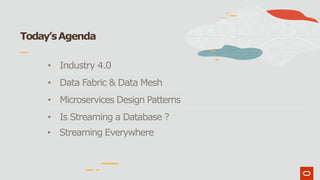





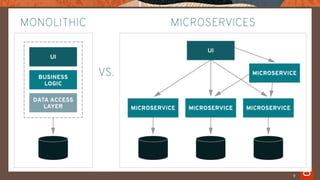

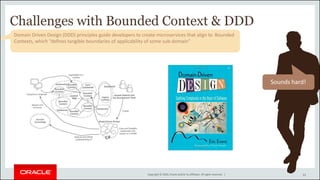

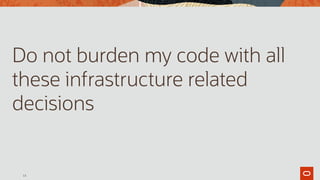


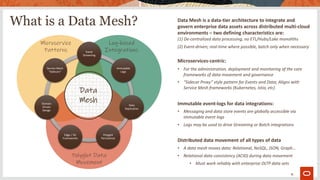
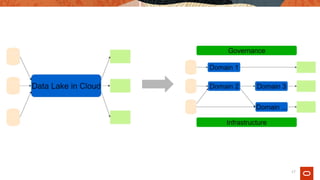
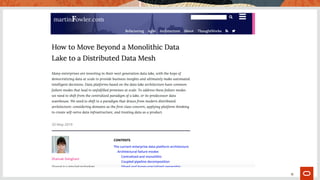
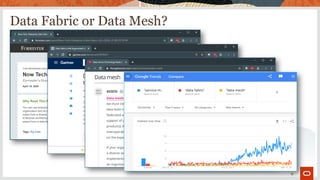

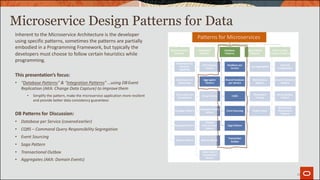
![Hype Cycle 2009
Complex Event Processing:
• CEP is a kind of computing in which incoming data about
events is distilled into more useful, higher level event data
that provides insight into what is happening. […] CEP is
used for highly demanding, continuous-intelligence
applications that enhance situation awareness and
support real-time decisions. Gartner
20 Years Too Early?
• CEP dates back to the 1990’s (history of CEP engines)
• CEP came before “Event Stream Processing” andgenerally
has covered more complex use cases (eg; handling of out-
of-order events and more complicated correlation
semantics) ( what’s the difference, 2019 and mythbuster
CEP vs ESP, 2008)
• Largely overtaken by Big Data stream processing
technologies that are open-source, massively-parallel,and
widely available as cloud-native
2009!
Copyright © 2020 Oracle and/or its affiliates.](https://image.slidesharecdn.com/dataengineerpatternsarchitecture-200616130532/85/Data-Engineer-Patterns-Architecture-The-future-Deep-dive-into-Microservices-Patterns-with-Stream-Process-22-320.jpg)

![Stream Processing/CEP for Event Driven Architectures
There has been a widespread
awakening to the benefits of Event
Drive Architecture (EDA) for
increasing the scalability and agility of
business systems. […] Stream
analytics is based on the mathematics
of complex-event processing (CEP).
CEP is a computing technique in
which incoming data about what is
happening (event data) is processed
as it arrives (data in motion or
recently in motion) to generate
higher level, more useful, summary
information (complex events).
W. Roy Schulte (of Gartner), March 2020:
EDA is Suddenly Popular Will Stream Analytics be Next?
Event Stream Analytics (& CEP)
Data & Microservice Events
Event/Data
Pipelines
Time-Series
Analysis
Geospatial
Analysis
Real-time
AI/ML
Continious
ETL
Use Cases:](https://image.slidesharecdn.com/dataengineerpatternsarchitecture-200616130532/85/Data-Engineer-Patterns-Architecture-The-future-Deep-dive-into-Microservices-Patterns-with-Stream-Process-24-320.jpg)





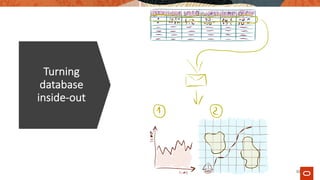






![Spark, Flink or KSQL
Copyright © 2019 Oracle and/or its affiliates.
[best] ˜œ›™[worst]
Spark
Streaming
Apache
Flink / SQL
Confluent
KSQL
User Experience
Low Code Development (with built-in patterns/accelerators) ™
Interactive/Live Edits (browser based, view changes immediately) ™ ˜
Built-in Live Dashboards (event-driven charts/graphs) ™
Core Streaming Semantics
What is Being Computed (transforms, joins, flatten, statefulness etc) › œ œ
Time Windows(global, fixed, sliding, tumbling, custom etc) › ˜ ˜
When in Processing Time (triggers – event, time, count, timers, etc) œ
How do Refinements Relate (discarding, accumulating, retracting) › œ
Analytics
Robust CEP Capabilities (complex event correlations, native time clock) ™
Geo-Fencing & Spatial (lat/long, built in maps, custom map tiles, etc) ™ ™ ™
Machine Learning (native scala, PMML, python support etc) œ œ
Time Series Analysis (built-in interval patterns, thresholding etc)
Other Features
Backpressure (dynamic ingest per pipeline) Custom Custom Custom
State Management (automation across streams & native cache) N/A RocksDB RocksDB
Data Consistency (OLTP Change Events, Inserts/Updates/Deletes) Custom Custom Custom
GoldenGate Stream Type (aware of SCN/CSN, transactions, order, etc) Custom Custom Custom](https://image.slidesharecdn.com/dataengineerpatternsarchitecture-200616130532/85/Data-Engineer-Patterns-Architecture-The-future-Deep-dive-into-Microservices-Patterns-with-Stream-Process-37-320.jpg)

